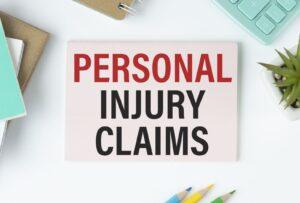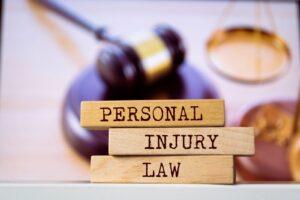
Getting Compensated For Your Injuries
If you have suffered any kind of injury as a result of someone else’s behavior, whether it was from a driver speeding their car through an intersection, a pet owner letting their dog off its leash to bite, or a business owner allowing a hazardous condition to exist on their property, you may be entitled to file a personal injury claim to be compensated for your injuries or other financial damages.
According to the U.S. Department of Justice (DOJ), there are over 400,000 personal injury claims filed in court every year. Only about 4% of cases (approximately 16,400) ever go to trial; most cases are settled out of court. According to data collected by the DOJ:
- About 52% of personal injury cases are the result of motor vehicle accidents
- Medical malpractice cases account for 15% of personal injury claims
- Product malfunctions (“Product liability”) is the basis for 5% of personal injury claims

What Is a Personal Injury Claim?
A personal injury claim is simply a lawsuit. You file this kind of lawsuit in court when you are injured—either physically or financially—because someone else acted in a way that was negligent or careless, and their behavior resulted in some harm to you. This harm or injury could be a physical injury, like a cut or laceration, a broken bone, an internal injury, or a long-term disability. It could also include financial damage that you suffer as a result of the event, such as the cost of repairing your car, medical bills, or loss of income resulting from having to miss work because of your injuries.
Contact our Kansas city personal injury lawyers now.

What Is the Likelihood of Winning a Personal Injury Claim?
When you file a personal injury claim for damages, you are asking the court to listen to the facts of your case and determine that the other party was negligent, that their negligence caused you to be injured, and that your injuries can be compensated.
According to data collected by the DOJ, for the small percentage of personal injury cases that go to trial:
- Plaintiffs involved in motor vehicle accidents are successful at trial 61% of the time.
- Plaintiffs injured on someone else’s property are successful at trial 39% of the time.
- Plaintiffs injured by faulty products win 38% of their cases at trial.
- People who sue their physicians are successful in only 19% of the cases that go to trial.
There are many reasons for the difference in success rates, but most cases are won or lost based on the amount and quality of the evidence that each party is able to present to the court to defend their position. In general, there is usually more evidence available in motor vehicle cases than there is in medical malpractice cases. Despite these differences, however, every plaintiff must prove the same thing in every personal injury case.

What Kind of Evidence Do I Need in a Personal Injury Case?
Even in motor vehicle accident cases, personal injury claims can be difficult to prove for many reasons. For example,
- The other party may have a different version of what happened.
- You may not be exactly sure what happened.
- There may not be any witnesses.
- The person who was responsible for your accident may not have been involved in the accident (it could be a manufacturer or designer).
- You may be partly at fault for what happened.
- Your injuries may not be obvious or may not present themselves right away.
- Your injuries may be long-term and may be difficult to value.
These are common hurdles that must be overcome to be successful in personal injury cases. The more evidence you have, the more likely you will be successful at trial. If you do not go to trial, you may settle your case with the other party or their insurance company. The more evidence you have, the more likely you will be to reach a fair settlement. But what kind of evidence do you need?
Evidence that the other party was negligent.
The most important thing to prove when filing a personal injury claim is that the other party was negligent. This means you must present facts that show:
- The other party had a “duty of care.” Having a “duty of care” means that you are expected to act with a certain degree of responsibility under the circumstances. For example, when a driver gets behind the wheel of a car, they are expected to be sober, alert, and cautious and follow the rules of the road. When a physician prescribes medicine or performs surgery, they are expected to be well-informed, skilled, and able to satisfy the medical standards that are commonly accepted within the profession. Every actor has a duty to act in a way that is responsible and expected.
It may seem that a duty of care is obvious: drivers should not be drunk; doctors should not make mistakes; products ought to work. But proving a duty of care is not that simple. The evidence required to prove a duty of care is based on the laws and standards in place that govern social behavior. For example, there are laws that prohibit operating a vehicle at a certain level of intoxication. In a drunk driving personal injury claim, the duty of care may be shown by identifying the law that prohibits driving with an unacceptable blood alcohol level. For a medical malpractice claim, you may need a medical professional to testify about the standard skill level that is expected of a physician performing a certain task or procedure under specific conditions.
Proving that the other party owed you a duty of care may seem obvious, but you still need evidence of what that duty is and that the other party assumed that duty.
- The other party breached their duty of care. To win a personal injury claim, it is not enough just to show that the other party owed you a duty to act responsibly. You also must show that the other party “breached” that duty or failed to live up to the standard of behavior that the law requires or that society expects.
So, for example, for your vehicle accident case, you must present evidence showing that the other driver was intoxicated, distracted, or careless when driving. The evidence you may need for this may be a medical professional’s testimony of what the driver’s blood alcohol content was at the time of the accident. Perhaps you may have witnesses who can testify that the driver was reaching in the back seat when they struck your car or that the traffic light was red when they drove through the intersection. In a medical malpractice claim, you might present evidence showing that your doctor performed a procedure that most other doctors hold to be ineffective, prescribed medicine that scientist have shown to be dangerous, or failed to take standard precautions in treating you. You cannot just state opinions about the other party’s breach of duty. You must present facts that support this claim.
- The other party’s negligent behavior caused your injuries.
Why You Need an Experienced Personal Injury Attorney
There are many important aspects of filing a car accident claim. Only a few are discussed here. However, even if you know:
- What to do immediately after a car accident
- The importance of a police report
- Who was at fault
- When to file your claim
- How to deal with insurance companies
- How to value your injuries, and
- How to prove damages,





